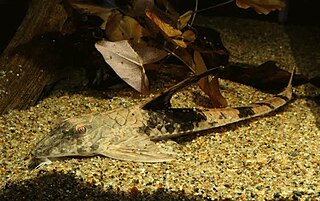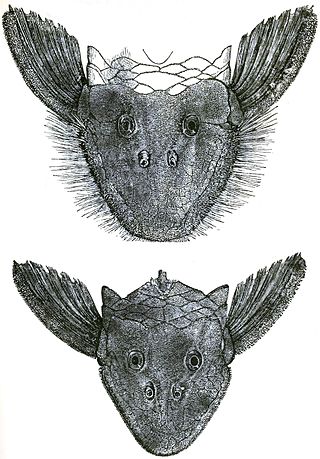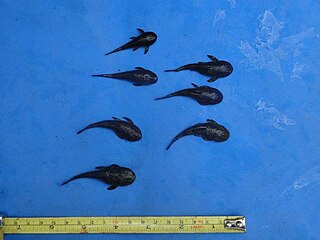
Ancistrus is a genus of nocturnal freshwater fish in the family Loricariidae of order Siluriformes, native to freshwater habitats in South America and Panama. Fish of this genus are common in the aquarium trade where they are known as bushynose or bristlenose catfish. In the aquarium hobby they are often referred to as bushynose or bristlenose plecos instead, but this may lead to confusion as "pleco" usually is used for Hypostomus plecostomus and its allies and is often used as a catchall term for any loricariids remotely resembling that species.

Hypostomus plecostomus, also known as the suckermouth catfish or the common pleco, is a tropical freshwater fish belonging to the armored catfish family (Loricariidae), named for the longitudinal rows of armor-like scutes that cover the upper parts of the head and body. Although the name Hypostomus plecostomus is often used to refer to common plecostomus sold in aquarium shops, most are actually members of other genera.

Loricariidae is the largest family of catfish, with 92 genera and just over 680 species. Loricariids originate from freshwater habitats of Costa Rica, Panama, and tropical and subtropical South America. These fish are noted for the bony plates covering their bodies and their suckermouths. Several genera are sold as "plecos", notably the suckermouth catfish, Hypostomus plecostomus, and are popular as aquarium fish.

Hypostomus is a genus of catfish in the family Loricariidae. They are native to tropical and subtropical South America. H. plecostomus is the popular freshwater aquarium fish formerly known as Plecostomus plecostomus. The taxonomic structure of the Loricariidae is still being expanded by scientists. Hypostomus is a highly species-rich and widely distributed catfish genus.

The genus Panaque contains a small number of small to medium-sized South American suckermouth armoured catfishes that are notable for being among the very few vertebrates that feed extensively on wood. In addition, algae and aufwuchs are an important part of the diet, and they use their rasping teeth to scrape this from rocks. These fish are also popular aquarium fish, where the sound of scraping as these fish forage for food is easily audible.

Pterygoplichthys, sometimes collectively known as janitor fish, is a genus of South American armored catfishes. These fish are commonly known as sailfin armoured catfish or sailfin plecs, especially in the aquarium trade.

Acanthicus is a genus of large, South American suckermouth armored catfishes native to the Amazon and Orinoco basins, and possibly in Guyana. The name Acanthicus is derived from the Greek, akanthikos meaning thorny, spiny. Fish of this genus are known as lyre-tail plecos. These species are found in large rivers, primarily in areas with a rocky bottom and a moderate or strong current.

Baryancistrus is a genus of freshwater Loricariid catfish. They inhabit flowing sections of rivers, especially clearwater, in the basins of the Amazon and Orinoco in Brazil and Venezuela. The largest species reach up to 34 cm (13 in) in total length.

Pseudancistrus is a genus of suckermouth armored catfishes native to South America.

Hypancistrus is a genus of loricariid catfish originating from the Amazon basin in South America. Unlike many of the other Loricariids, however, some Hypancistrus species are more carnivorous and enjoy meat in their diet. Hypancistrus species are popular aquarium fish, including such popular fish as the zebra pleco and Queen Arabesque pleco.

Peckoltia is a genus of small South American armored suckermouth catfishes. Many of these fish are popular aquarium fish.

Hemiancistrus is a genus of suckermouth armored catfishes. These species are native to South America. The taxonomy of this genus is complex and unclear, and major work has to be done. Many of these fish are popular aquarium fish.

Corymbophanes is a genus of armored catfish native to South America where they are only known from Guyana. Corymbophanes was originally placed in its own tribe Corymbophanini, but the first comprehensive molecular phylogenetic analysis of the subfamily Hypostominae found Corymbophanes to be nested within the tribe Ancistrini.

Rhinelepini is a tribe of fishes in the subfamily Hypostominae of the armored suckermouth catfish family Loricariidae.
Pogonopoma is a genus of armored catfish native to rivers in south and southeast Brazil.

Rhinelepis is a genus of South American armored catfish.

Ancistrini is a tribe of catfishes of the family Loricariidae. Most are restricted to tropical and subtropical South America, but there are also several genus in southern Central America.

Pseudacanthicus is a genus of medium to large-sized suckermouth armored catfishes native to South America, where found in the Amazon and Orinoco basins, as well as rivers of the Guianas. They are primarily found in fast-flowing waters, sometimes relatively deep. They are sometimes kept in aquariums.
Pterygoplichthys weberi is a species of catfish in the family Loricariidae. It is native to South America, where it occurs in the basins of the Amazon River, the Japurá River, the Marañón River, and the Ucayali River in Colombia, Ecuador, and Peru. The species reaches 19.7 cm in standard length and is known to be a facultative air-breather.
Ancistomus feldbergae is a species of catfish in the family Loricariidae. It is native to South America, where it occurs in the Xingu River basin in Brazil.


















